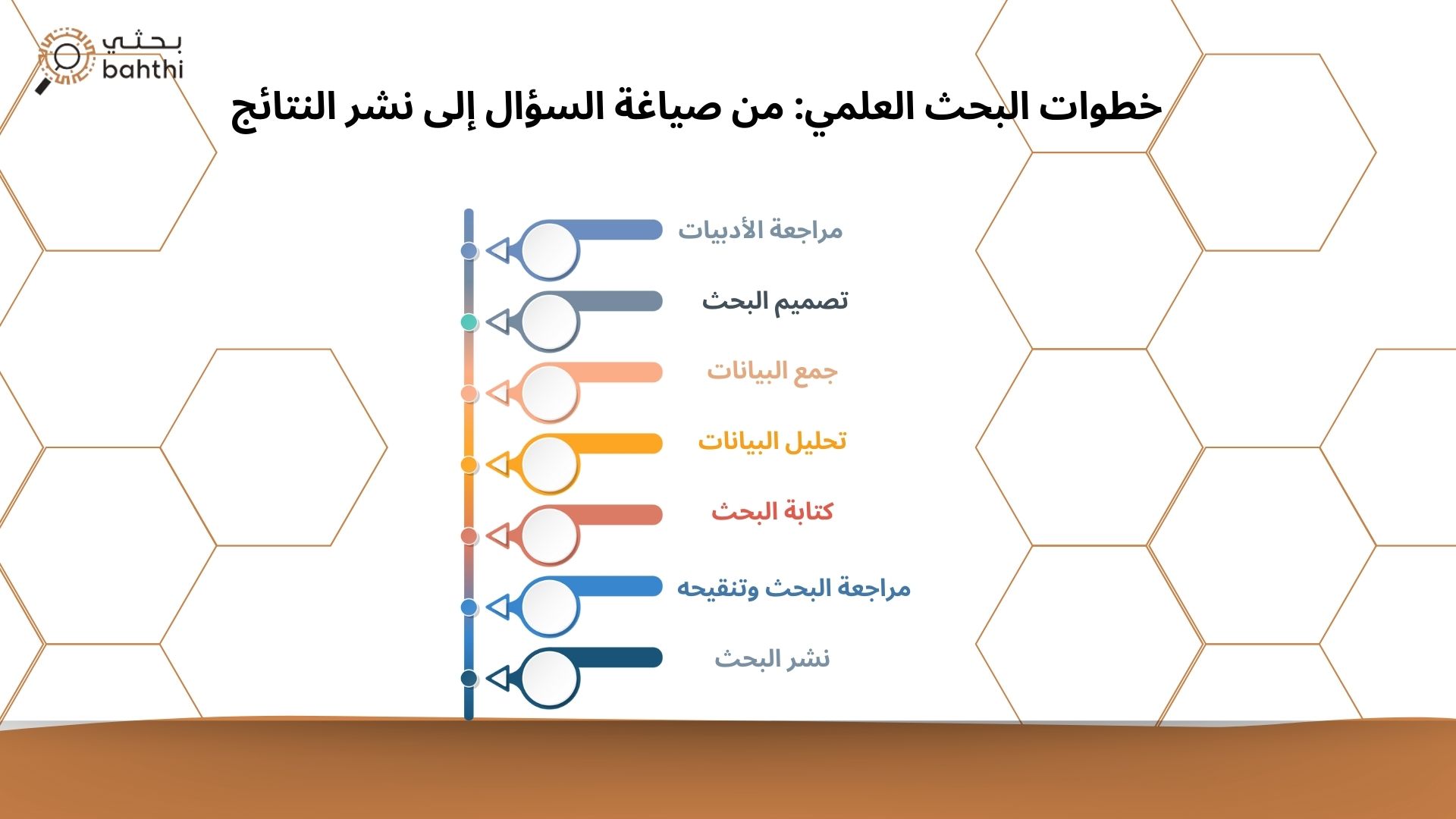

Steps of scientific research: from the formulation of the question to the publication of the results
By following a specific methodology, researchers can develop an organized research plan that determines how to implement each stage of research, including sample identification, selection of data collection methods, and identification of analysis tools.
This organization helps in managing time and resources effectively, reduces the chaos that may result from the lack of a clear plan, a good arrangement enhances the smooth conduct of research and helps in reaching integrated and reliable results.
Literature review the first steps of scientific research
Literature review is the first and basic scientific research step in any scientific research process, this stage is the basis on which the entire research is built, as it aims to collect and analyze the available information on the studied topic through the study of previous research, scientific articles and books.
This step aims to achieve several vital and fundamental goals for the success of scientific research and to make new and valuable contributions.
Objectives of scientific research steps:
1. Understanding the current state of knowledge in the specific field scientific research steps help the researcher to familiarize himself with what already exists in his field of research, by analyzing previous studies, the researcher can determine the scope of studies that dealt with the same topic and understand the developments and ideas discussed, this provides him with a comprehensive view of the current state of knowledge and gives him a strong base to launch his own research.
2. Identifying research gaps one of the most important goals of scientific research steps is to reveal the research gaps that exist in the studied field. this means identifying topics that have not been studied sufficiently or aspects that need further research and analysis.the researcher can direct his research to fill these gaps, which enhances the importance of his study and contributes to the development of knowledge in this field.
3. Avoiding repetition and making new contributions through the steps of scientific research, the researcher can make sure that his study has not been carried out before in the same way or to address the same problem, this helps to avoid unnecessary repetition of previous studies.
In addition, the researcher can build on previous research, make new and unique contributions based on the development of existing ideas and concepts.
Research design
After completing the scientific research steps, the research design step comes, which is an important stage that requires determining the methods and tools that will be used to collect and analyze data.
There are several approaches that can be used in scientific research, such as the quantitative approach, which is based on numbers and statistics, and the qualitative approach, which is based on description and deep analysis.
The researcher should also at this stage determine the target sample and choose the appropriate tools for data collection, such as questionnaires, interviews, observations. In addition, the researcher must ensure that the research design is in line with ethical principles and ensures that the participants do not suffer any harm.
Data collection
The data collection phase comes after the development of the research design, which is a crucial step that requires accuracy and discipline to ensure obtaining correct and reliable information.data collection methods depend on the type of research and its design, and can include questionnaires distributed to the target sample, conducting individual or group interviews, or collecting data from secondary sources such as official records or reports.
At this stage, the researcher must ensure that the tools used to collect data are reliable and credible, and that the data is collected in an organized and systematic way to ensure ease of analysis in the next stage, and the researcher must maintain the confidentiality of information and respect the privacy of participants.
In the steps of scientific research, data collection is a pivotal stage that requires adherence to strict standards to achieve reliable results.the effective implementation of scientific research steps at this stage contributes to ensuring the quality of data and the integrity of research results.
Data analysis
The data analysis stage is one of the most important steps of scientific research, in which the collected raw data is transformed into understandable and scientifically significant information.
Data analysis requires the use of statistical methods and appropriate software tools for research, such as SPSS, Excel, or R programs. This stage aims to test the hypotheses put forward, and draw conclusions that support or deny those hypotheses.
The analysis begins with the process of cleaning the data to ensure that it is free of errors or abnormal values, and then appropriate analyzes are carried out, which may include descriptive analyzes such as averages and standard deviation, or deductive analyzes such as regression and factor analysis.
Writing research
After completing the data analysis and drawing conclusions, the stage of writing the research comes, which is an important step that requires organizing the information clearly and systematically.the research is divided into several main sections, including introduction, literature review, research methodology, results, discussion, and conclusion.
In the introduction, the researcher presents the research problem and its importance, identifies hypotheses or research questions, followed by a literature review that summarizes previous studies and clarifies the research gaps that the research seeks to fill, in the research methodology section, the researcher explains the research design and tools used to collect and analyze data.
The results section presents the results derived from the analysis, clarifying the supporting tables and graphs, while the discussion section deals with the interpretation of the results and linking them with previous studies, clarifying the research contributions and recommendations, the research concludes with a conclusion that summarizes the most important results and provides future recommendations.
The scientific research steps of writing a research paper are a crucial step to ensure that the results and information are presented in an organized and comprehensive manner.following the scientific research steps accurately at this stage enhances the clarity of the research and increases its scientific value.
Review and revision of the research
The stage of reviewing and revising the research comes after writing the first draft, this step is necessary to ensure the quality of the research and its freedom from linguistic or scientific errors.
The researcher thoroughly reviews all sections, focusing on making sure the accuracy of the data and information provided, the researcher can use his colleagues or supervisors to obtain constructive feedback that will help improve the research.
The revision process includes modifying paragraphs to be clearer and smoother, paraphrasing sentences that may be inaccurate or ambiguous, and making sure that the research adheres to academic standards and the appropriate scientific writing style.
In the scientific research steps, the review and revision of the research is a vital stage to ensure the improvement of the quality and the final form of the research.
Publish the research
After the completion of the review and revision of the research, the stage of publishing the research comes, which is a crucial step in the scientific research process, as it is an important means of disseminating scientific results and contributions.publishing the research in a peer-reviewed scientific journal or scientific conference allows researchers to make their scientific contributions to the academic community and participate in the development of knowledge in their field of specialization.
Choosing the right journal or conference
The first step in the process of publishing research is to choose the appropriate journal or scientific conference for the research field, this requires careful study of the available journals or conferences and identify those that correspond to the research topic and objectives.
This includes considering factors such as the scope of the magazine, its reputation, impact factor, and the category of the target audience. The researcher can use his supervisors or colleagues in the field to get recommendations for appropriate journals or conferences.
Preparing the research according to the requirements of the publication
After choosing the journal or conference, the researcher has to prepare the research according to its publication requirements, these requirements usually include text format, citation style, forms of tables and graphs.
The requirements for publication vary from one journal to another, so the researcher should carefully read the authors ' guide to the Journal and adhere to all instructions.
Text format and writing style
The researcher should format the research text in a way that complies with the requirements of the journal, such as font size, font type, paragraph spaces, and Section titles, and should also use the appropriate citation style specified by the Journal, whether it is APA, MLA, or others.
Tables and diagrams
Tables and graphs are an important part of research, as they help clarify data and results. These items should be clear and detailed, comply with the magazine's instructions on their design and format, preferably use the appropriate colors and accurate labels to ensure their easy understanding.
Research submission and peer review
After preparing the research according to the requirements of the Journal, the researcher submits it to the journal for publication, when submitting the research, it undergoes peer review, a process in which the research is evaluated by experts in the field. These experts thoroughly review the research and provide their feedback and recommendations on it.
Peer review
Peer review includes checking the quality of the research, the accuracy of the results, the methodology of the research, and the importance of scientific contributions.the results of peer review may range from accepting the research for publication, acceptance with amendments, or rejection. this process aims to ensure the quality of the research and its suitability for publication in the scientific journal.
Importance of research publication
The publication of research is an essential step to popularize scientific knowledge and contribute to the development of the academic field. By publishing research, researchers are able to:
* Knowledge exchange: the publication of research allows researchers to exchange knowledge and experience with their colleagues in the field, which enhances scientific cooperation and stimulates further studies.
* Enhancing academic reputation: the publication of research contributes to building the academic reputation of the researcher and enhancing his position in the scientific community.
* Support scientific progress: the publication of research contributes to the provision of new contributions and new knowledge, which supports scientific progress and contributes to solving scientific and applied problems.


